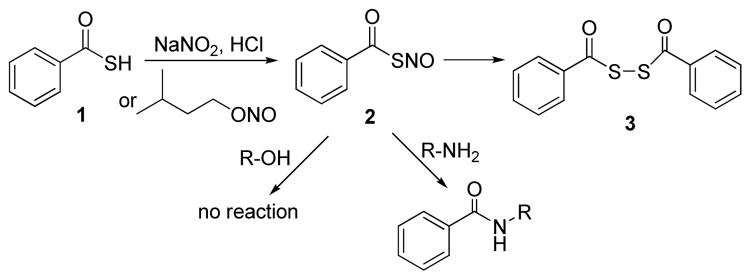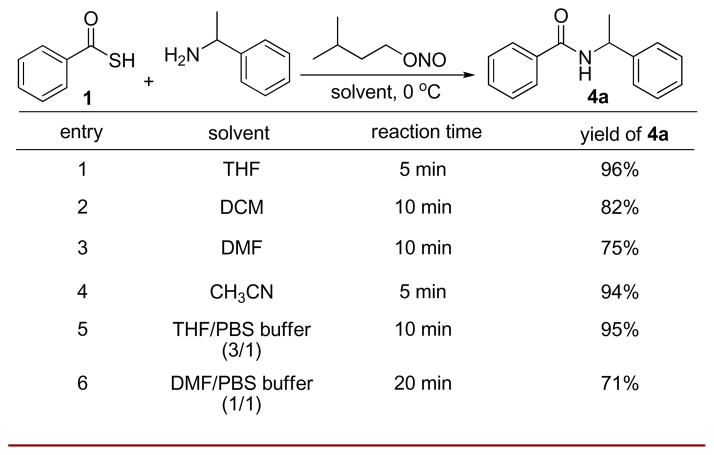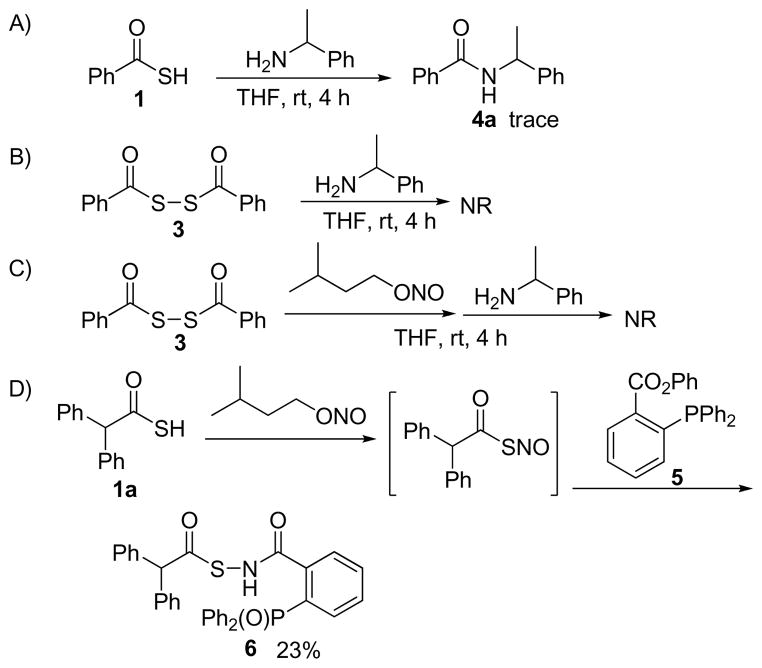Abstract

Here we report a novel amide bond formation strategy from simple thioacid and amine starting materials. The reaction is mediated by unstable, but very reactive S-nitroso thioacid intermediates. This fast reaction under mild conditions should be useful in synthesis.
Due to the importance in biology and drug discovery, amide or peptide bond formation is an active area in organic chemistry. In the past decade, a number of new strategies for the construction of amide bonds have been discovered.1 In particular, thioacid or thioester derivatives are attractive starting materials. Recent studies have revealed some unique reactivity of these sulfur-based compounds and demonstrated some advantages of them compared to carboxylic acid derivatives in amide and peptide bond forming sequences.2 In our recent efforts to study new chemistry of thiol S-nitrosation, 3 we envisioned that if thioacids were subjected to nitrosation (Scheme 1), the corresponding S-nitroso thioacids (NTA) could be formed. Such a sulfur-nitrosation process may activate thioacids and lead to a facile acylation with certain nucleophiles. Herein, we report a very efficient amide bond formation mediated by NTA.
Scheme 1.
Proposed NTA coupling
It is known that S-nitrosothiols are unstable moieties. Their chemistry, especially synthetically useful reactions, has not been well studied.4 NTA type molecules have never been clearly identified, although such compounds may be involved in some thiyl radical formation process.5 In our study, we first tested the preparation of NTA. One example using thiobenzoic acid 1 is shown in Scheme 2. Compound 1 was treated with organonitrite (RONO) or HCl/NaNO2 in organic solutions at rt or 0 °C. The resulted species, presumably NTA 2, showed a deep green color (UV spectra of 2 were shown in the Supporting Information), which is the characteristic color of tertiary S-nitrosothiols. The NTA 2 appeared to be unstable as the green color readily faded when we attempted to isolate compound 2. The final isolated product was disulfide 3, which is the expected decomposition product from S-nitrosothiols. Although NTA 2 was unstable, we tested the idea to trap NTA in situ with some nucleophiles. Amines proved to be excellent substrates and the formation of amide bonds were achieved in a very effective way (see table 1 below). It was also remarkable that NTA, unlike other activated carboxylic acid derivatives, did not show any reactivity toward hydroxyl groups (such as benzyl alcohol, phenol, and N-hydroxysuccinimide). This is promising for further study of selective N-acylation.
Scheme 2.
Formation of NTA and the reaction of NTA
Table 1.
NTA mediated amide coupling
 | |||
|---|---|---|---|
| entry | thioacid | amine | product/yield |
| 1 |
 1 |
BnNH2 |
 4b (100%) |
| 2 |
 4c (97%) |
||
| 3 |
 4d (80%) |
||
| 4 | Bn2NH |
4e (88%) |
|
| 5 |
 4f (89%) |
||
| 6 |  |
 4g (77%) |
|
| 7 |
1b |
BnNH2 |
 4h (86%) |
| 8 |
 4i (87%) |
||
| 9 |  |
 4j (89%) |
|
| 10 |  |
 4k (81%) |
|
| 11 |
 1c |
 |
 4l (86%) |
| 12 |  |
 4m (80%) |
|
| 13 |
 1d |
 4n (87%) |
|
| 14 |
1b |
PhNH2 |
4o (71%) |
We then optimized the conditions for this NTA mediated coupling between thioacids and amines. The best procedure was to mix the thioacid (1.0 eq) and the amine (1.1 eq) at 0 °C. Commercially available amyl nitrite (2.0 eq) was then added dropwise into the solution. In this process, no additional base was needed. The formation of the desired amide product was observed immediately and in high yields (monitored by TLC). As shown in Scheme 3 (entries 1–4), this reaction worked nicely in a number of common solvents including THF, DCM, DMF, and CH3CN. Water seemed to have little effect on the coupling as the reaction gave similar results in buffer containing systems (entries 5 and 6). This process proved to be a very fast process as in all the solvents the reaction completed in minutes at 0 °C.
Scheme 3.
Solvent effects of NTA mediated amide formation
To prove the reaction was indeed involving NTA, we carried out several control experiments (Scheme 4). The reaction between thioacid 1 and α-methyl-benzylamine only led to the formation of amide 4a in trace amount at rt, even when the amine was used in large access (10 eq). Previous report by Orgel et al also suggested that thioacids should not directly react with amines to form amides.2i As NTA are unstable species and could easily decompose to form disulfides, we then tested the reaction between disufide 3 and α-methyl benzylamine. Again, we did not observe the formation of the amide product (Scheme 4-B). The addition of amyl nitrite into disulfide 3 did not lead to any amide formation either (Scheme 4-C). Finally, we tried to capture the unstable NTA intermediates using the reductive ligation,3a which is a specific reaction of SNO groups. After several attempts, we were able to obtain the desired ligation product 6 using substrate 1a (Scheme 4-D). Although the yield of 6 was only 23%, the formation of this sulfenamide product strongly supported the presence of NTA intermediate in the reaction.
Scheme 4.
Control experiments
The results shown above suggested that NTA act as an effective activating group to facilitate amide formation. To test the generality of this reaction, a series of thioacids and amines were employed under the optimized conditions (Table 1). The reaction proved to be very efficient with not only primary amines, but also sterically hindered secondary amines (entries 1–8). We also tested several amino acids substrates. As expected, the corresponding dipeptide products were obtained in good yields in all substrates (entries 9–14). As shown in entry 10, free hydroxyl group did not interfere with the reaction, which was consistent with our previous selectivity results. In all the cases, the reaction was able to complete in 10 minutes at 0 °C.
In summary, we presented here a novel amide bond formation strategy from simple thioacids and amines. This process was mediated by reactive NTA intermediates. It revealed nitrosation as a novel strategy for thioacid activation. Compared to other amide formation methods, this reaction only utilized readily available organonitrite as the activation reagent. It took place under very mild reaction conditions and the reaction rate was extremely fast. The chemistry is easily executed. It also showed excellent selectivity toward amines over hydroxyls. In our opinion, this method should be promising for peptide coupling/ligation and selective N-acylation. Further studies on detailed reaction mechanism, the application of this method in synthesis and biology, as well as exploring new chemistry of NTA are currently ongoing in our laboratory.
Supplementary Material
Acknowledgments
This work is supported in part by NIH (R01GM088226) and a CAREER award from NSF (0844931).
Footnotes
Supporting Information Available: Spectroscopic and analytical data and selected experimental procedures. This material is available free of charge via the Internet at http://pubs.acs.org
References
- 1.For selected reviews, see Bode JW. Curr Opin Drug Discovery Dev. 2006;9:765.Han S, Kim Y. Tetrahedron. 2004;60:2447.Nilsson BL, Soellner MB, Raines RT. Annu Rev Biophys Biomol Struct. 2005;34:91. doi: 10.1146/annurev.biophys.34.040204.144700.Kimmerlin T, Seebach D. J Peptide Res. 2005;65:229. doi: 10.1111/j.1399-3011.2005.00214.x.
- 2.For selected examples, see Bao Y, Li X, Danishefsky SJ. J Am Chem Soc. 2009;131:12924. doi: 10.1021/ja906005j.Wang P, Danishefsky SJ. J Am Chem Soc. 2010;132:17045. doi: 10.1021/ja1084628.Crich D, Sasaki K. Org Lett. 2009;11:3514. doi: 10.1021/ol901370y.Crich D, Sharma I. Angew Chem Int Ed. 2009;48:2355. doi: 10.1002/anie.200805782.Crich D, Sharma I. Angew Chem Int Ed. 2009;48:7591. doi: 10.1002/anie.200903050.Crich D, Sana K, Guo S. Org Lett. 2007;9:4423. doi: 10.1021/ol701583t.Dawson PE, Muir TW, Clark-Lewis I, Kent SBH. Science. 1994;266:776. doi: 10.1126/science.7973629.Dawson PE, Churchill, Ghadiri MR, Kent SBH. J Am Chem Soc. 1997;119:4325.Liu R, Orgel LE. Nature. 1997;389:52. doi: 10.1038/37944.Shangguan N, Katukojvala S, Greenberg R, Williams LJ. J Am Chem Soc. 2003;125:7754. doi: 10.1021/ja0294919.Sheehan JC, Johnson DA. J Am Chem Soc. 1952;74:4726.
- 3.(a) Wang H, Xian M. Angew Chem Int Ed. 2008;47:6598. doi: 10.1002/anie.200801654. [DOI] [PubMed] [Google Scholar]; (b) Zhang J, Wang H, Xian M. J Am Chem Soc. 2009;131:3854. doi: 10.1021/ja900370y. [DOI] [PubMed] [Google Scholar]; (c) Wang H, Xian M. J Am Chem Soc. 2009;131:13238. doi: 10.1021/ja905558w. [DOI] [PubMed] [Google Scholar]; (d) Zhang J, Li S, Zhang D, Wang H, Whorton AR, Xian M. Org Lett. 2010;12:4208. doi: 10.1021/ol101863s. [DOI] [PMC free article] [PubMed] [Google Scholar]; (e) Zhang D, Devarie-Baez NO, Pan J, Wang H, Xian M. Org Lett. 2010;12:5674. doi: 10.1021/ol102491n. [DOI] [PMC free article] [PubMed] [Google Scholar]; (f) Devarie-Baez NO, Xian M. Org Lett. 2010;12:752. doi: 10.1021/ol9028447. [DOI] [PubMed] [Google Scholar]
- 4.For selected reviews on S-nitrosothiols, see Williams DLH. Acc Chem Res. 1999;32:869.Szacilowski K, Stasicka Z. Prog React Kinet Mech. 2001;26:1.Al-Sadoni HH, Ferro A. Current Med Chem. 2004;11:2679. doi: 10.2174/0929867043364397.Wang PG, Xian M, Tang X, Wu X, Wen Z, Cai T, Janczuk AJ. Chem Rev. 2002;102:1091. doi: 10.1021/cr000040l.
- 5.Potapenko DI, Bagryanskaya EG, Tsentalovich YP, Reznikov VA, Clanton TL, Khramtsov VV. J Phys Chem B. 2004;108:9315. [Google Scholar]
Associated Data
This section collects any data citations, data availability statements, or supplementary materials included in this article.






